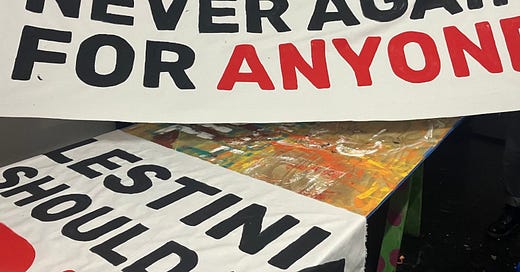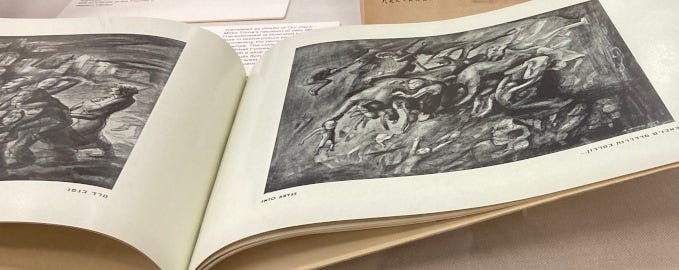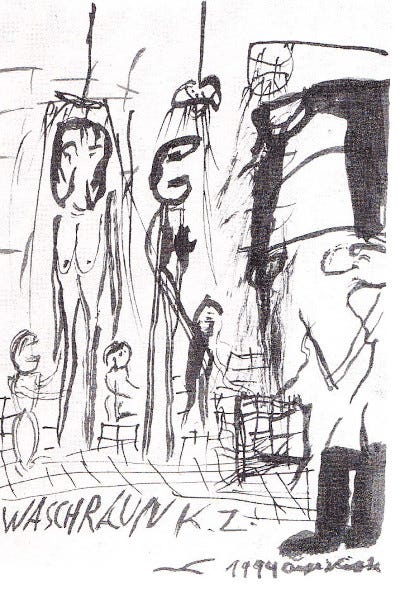Reviews:
Artists of the Holocaust: Portfolios, Exhibition Catalogs, and Monographs. April 20–November 14, 2023, Watson Library, Metropolitan Museum of Art. https://www.metmuseum.org/exhibitions/holocaust-artist
Ceija Stojka: What Should I be Afraid of? Austrian Cultural Forum 11 East 52nd Street, New York May 23, 2023-September 25, 2023. CLOSED.
“I have learned from you that the possibility of wanting change does not have to be bought with the renunciation of one’s own happiness.”
„Ich habe von Dir gelernt, daβ die Möglichkeit, das Andere zu wollen, nicht mit dem Verzicht aufs eigene Glück erkauft werden müsse. Theodor Adorno to Max Horkheimer.“1
In James Thurber’s master story, The Thirteen Clocks, that mysterious character, the Golux, confronts the logic of the present: to free the Princess Saralinda he must unfreeze the hands of thirteen clocks. And, since Saralinda is the only warm thing in Coffin Castle, by placing her warm hand on each clock’s hand, he reasons, she will unfreeze it. When the tactic fails the Golux reasons that since placing Saralinda’s hand does not unfreeze the clocks, not placing Saralinda’s hand will un-not-unfreeze them. Golux is a master syllogist.
Also master of the long shot. The Cold Duke of Coffin Castle demands a thousand jewels in exchange for Saralinda. It is possible, thinks the Golux, that in the next town lives a person who cries jewels. Maybe not. It’s worth a try.
I signed up to letter signs and banners for Jewish Voices for Peace. I figured with my skills I should be able to provide some great visuals. Fortunately I never made it to the party. By not turning up I helped Jewish Voices for Peace turn out some thoroughly disciplined banners: non-artistic, dull as dishwasher, focused on the message, not some arty self. If you can’t achieve change by doing X, then change can be achieved by not-doing X.
The French Surrealist René Char has something similar to say. He writes:
« Dans les nacelles de l'enclume Vit le poète solitaire, Grande brouette des marécages. »
“In the anvil’s shock absorbers Lives the solitary poet Great wheelbarrow of the marshes.”
One might imagine Char is calling for the artist to remain aloof from the mundane and the political: inter armas silent artes. Except, Char himself was active in the Résistance, writing poetry as he fought but refusing to publish until he’d stopped fighting. Char, like the Golux, wants us to see the distinct power of our aesthetic powerlessness. The question is not whether one should or should not write poetry or make paintings, the question is, what is the proper distance between the hand and the clock?
Theodor Adorno, too, was much concerned about this question: could one write poetry after Auschwitz, or make a painting? Obviously one could. But it would suck:
The Watson Library at the Metropolitan Museum of Art has a couple of display cases out, memorial books produced immediately following the Churban, fine editions for lovers of the Book Beautiful. When Adorno wrote that “mere survival calls for the coldness, the grounding principle of bourgeois subjectivity” [Weiterleben bedarf schon der Kälte, des Grundprinzips der bürgerlichen Subjektivität], he must have meant this kind of cold:
“After Auschwitz our feelings reject all life-affirming claims as so much pontificating, an injustice toward the victims; they resist seeing their fate pressed into coherence, no matter how hackneyed.”
„Das Gefühl, das nach Auschwitz gegen jegliche Behauptung von Positivität des Daseins als Salbadern, Unrecht an den Opfern sich sträubt, dagegen, daß aus ihrem Schicksal ein sei's noch so ausgelaugter Sinn gepreßt wird.“2
For aesthetic relief (or un-relief) we turn to Ceija Stojka, a Sinti-Roma artists and poet and a survivor of Auschwitz:
One need only compare the perfectly mundane representation of the stifling lack of space in the various works on display at the Watson Library, with Stojka’s drawing. I’m pretty sure her work wouldn’t pass the test for competence, but isn’t that the point? Here is a competency, a hard-won competency of a different kind, one that resists coherence. There is hope.
Well, okay, there is no hope. We have to make our own from scratch.
WOID XXIII-29D
November 5, 2023
Part 3 of 4
Part 1: “Crazy Zionist Grampa”
Part 2: “Thoroughly Modern Moishe”
„Offener Brief an Max Horkheimer,“ 12 Februar 1965, Theodor Adorno, Gessamelte Schiften in 20 Banden, ed. Rolf Tiedemann et al (Frankfurt am Main: Suhrkamp, 1986), vol. 20.1 p. 158.
Theodor W. Adorno, Negative Dialektik (Frankfurt-am-Main: Suhrkamp, 1966), pp. 53-54, 352






